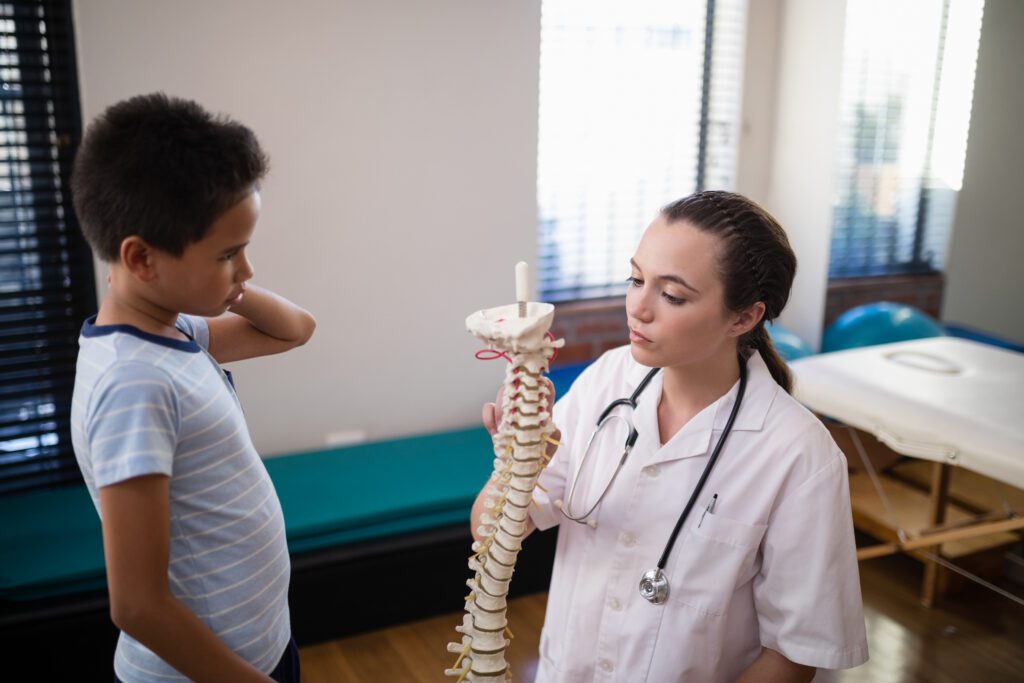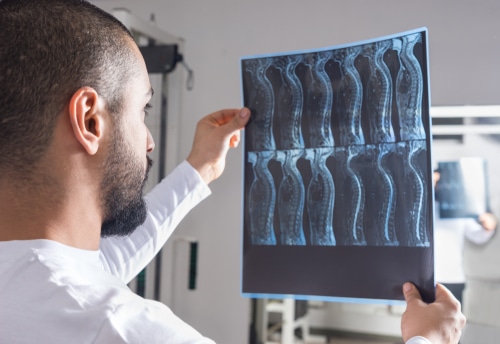Over 20,000 Australians live with a spinal cord injury (SCI) and use a wheelchair as a result. These injuries, often caused by accidents or medical conditions, can bring about significant changes in a person’s life.
From understanding the basics of what a spinal cord injury is to exploring the latest developments in treatment and recovery, this article seeks to address your most pressing questions about SCIs. Whether you’re directly impacted by a spinal cord injury or simply seeking to enhance your knowledge, here are some key insights.
In this article
- What is a spinal cord injury?
- What causes it?
- How does a spinal cord injury affect the brain?
- How does a spinal cord injury affect the body?
- What is a complete spinal cord injury?
- What’s the best treatment?
- Can I get stem cell treatment for it in Australia?
- What other medical breakthroughs have there been in treating a spinal cord injury?
- More reading about spinal cord injuries
- Insurance for your mobility device

What is a spinal cord injury?
A spinal cord injury is damage to the spinal cord, which is a long bundle of nerves that runs inside your backbone (spine). This cord plays a crucial role in transmitting messages between your brain and the rest of your body. When it gets injured, these messages can be disrupted, leading to problems with sensation, movement, or other body functions below the level of the injury.
At the time of writing, approximately 20,800 people in Australia have a spinal cord injury.
What causes it?
As mentioned, SCIs happen when there’s damage to the spinal cord. This can be caused by accidents, like car crashes or falls, where the spine gets hurt. It can also happen due to diseases or medical conditions that affect the spinal cord, like certain infections or tumours.

How does a spinal cord injury affect the brain?
An SCI doesn’t directly affect the brain itself, but it disrupts communication between the brain and the body parts below the injury site. The brain continues to function normally, however, it may struggle to send signals to and receive signals from the affected areas of the body.
How does a spinal cord injury affect the body?
SCIs can have a wide range of effects on the body, depending on the location and severity of the injury. Common consequences include:
- Loss of sensation: You may not feel touch, temperature, or pain in the affected areas.
- Muscle weakness or paralysis: You might lose the ability to move or control certain muscles.
- Changes in bodily functions: Spinal cord injuries can affect bladder and bowel control, sexual function, and blood pressure regulation.
- Respiratory issues: Severe injuries in the upper part of the spinal cord can impact breathing, hence you may require assistance with ventilation.
What is a complete spinal cord injury?
A complete spinal cord injury means that the damage is severe enough to completely block the transmission of signals between the brain and the body parts below the injury site. In other words, there is a total loss of both motor (movement) and sensory (feeling) function in the affected areas.
This is often associated with a specific level of the spinal cord where the injury occurred. People with complete injuries may have no sensation or voluntary muscle control below the level of the injury.

What’s the best treatment?
The best treatment for a SCI depends on how bad the injury is and where it happened along the spinal cord. For many, it’s about management of the injury rather than a treatment that will ‘fix’ it.
Here are some common options:
Surgery
Sometimes, surgery is needed to repair the spine or remove things pressing on the spinal cord. This can help reduce further damage.
Rehabilitation
Rehabilitation is essential for most people with spinal cord injuries. It involves physical therapy, occupational therapy, and other exercises to help you regain strength, movement, and independence.
Medications
Doctors may prescribe medications to manage pain, prevent infections, or control muscle spasms that can happen after a spinal cord injury.
Assistive devices
Devices like wheelchairs, braces, other mobility aids and special tools can help you adapt and manage daily activities. An Assistance Dog would also be of use.
Stem cell therapy
Stem cells are special cells that can develop into many different types of cells in the body. For an SCI, stem cells could be used to replace damaged nerve cells or to help the spinal cord repair itself. Read more on this below.
Can I get stem cell treatment for it in Australia?
You may be able to get stem cell treatment for an SCI in Australia. However, it’s important to note there are currently no proven, safe, and effective stem cell treatments for spinal cord injury available in Australia, the EU, America, or elsewhere.
Most stem cell treatments for SCI are currently in clinical trial – research studies that test and evaluate the safety and effectiveness of new treatments.
Clinical trials
To participate in a trial, you must meet certain criteria, such as having a specific type of spinal cord injury and being in good health. To find out if you’re eligible for one, you can talk to your doctor or search for open trials online. You can also contact Spinal Cord Injuries Australia on 1800 838 000 for more information.
If you’re not eligible for a clinical trial, there are also a few private clinics in Australia that offer stem cell treatment for spinal cord injury.
However, it’s important to note these treatments are not approved by the Therapeutic Goods Administration (TGA), the Australian government agency that regulates medical products. This means there’s no guarantee these treatments are safe or effective.
What other medical breakthroughs have there been in treating a spinal cord injury?
While there’s no cure for SCIs yet, there have been a number of recent advances that are giving hope to people with this condition.
Researchers are working hard to develop new and even more effective treatments, and it’s likely we’ll see even more progress in the years to come. They include:
Epidural stimulation
This is a treatment where doctors implant a device near the spinal cord that can send electrical signals. It has helped some people with spinal cord injuries regain some movement and function.
Robotics and exoskeletons
Exoskeletons are wearable devices that can help people with paralysis to walk again. They work by supporting the body and providing power to the legs. This technology is still in its early stages of development, but it has the potential to revolutionise the lives of people with spinal cord injury.
Read more about the latest innovations in assistive technology available today to find out about devices that could help with mobility after a SCI.
Medications and therapies
There are new medications and therapies being developed to manage pain, reduce inflammation, and promote nerve healing after spinal cord injuries.
Brain-computer interfaces
Brain-computer interfaces (BCIs), or brain chips, are devices that allow people to control external devices with their minds. Theoretically, they may one day be able to cure paralysis.
BCIs could be used by people with spinal cord injury to control wheelchairs, prosthetics, and ultimately, damaged limbs. They’re also still in their early stages of development, but they have the potential to give people with spinal cord injury a greater degree of independence.
The most well-known BCI at the moment is tech mogul Elon Musk’s Neuralink. You can read more about it here:
- Neuralink: What Is It and Can It Cure Paralysis and Blindness?
- Cyborg Limbs For Amputees – Elon Musk Announces Latest Vision
Improved surgical techniques
Surgical techniques for spinal cord injury have improved significantly in recent years. This has led to better outcomes for patients, including reduced chronic pain and inflammation, and improved nerve function.
Intensive rehabilitation programs
Intensive rehabilitation programs can help people with a SCI to maximise their functional recovery. These programs typically involve a variety of therapies, including physical therapy, occupational therapy, and speech therapy.
More reading about spinal cord injuries
Interested to read more about this type of injury and others’ experiences with it? Our blog has plenty of articles, such as:
- Spinal Cord Injury Awareness Week Key Insights
- Spinal Life Australia Inspires us to “Take Life Back”
- How to Get Involved on Spinal Cord Injury Awareness Day
- Why this Spinal Cord Injuries Australia Board Member Switched to Blue Badge
- Australia’s First Quadriplegic Inclusive Clothing Designer
- Research Advances You Should Know About for Brain Awareness Week 2023
Insurance for your mobility device
Blue Badge Insurance is Australia’s first disability and independence insurance specialist. We started with the goal of positively discriminating for people with disability and now, years later, we have a range of insurance solutions to suit.
Blue Badge offers insurance for wheelchair accessible vehicles and disability converted cars and mobility equipment, like wheelchair insurance. We also offer pet insurance for companion animals and Assistance Dogs insurance. It’s all about protecting the things that keep people living with disability as independent as possible, for as long as possible.
Contact us today to find out more.








